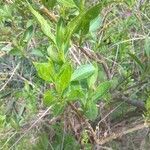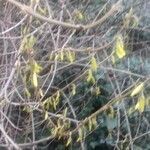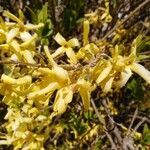A lax shrub. It can grow to 3 m tall when trained on a wall. It loses its leaves during the year. The branches are slender and arching. They are yellow-brown. The internodes are hollow. The leaves are simple but can also have 3 divisions. The leaf stalk is 0.8-1.5 cm long. The leaf blade is oval and 2-10 cm long by 1.5-5 cm wide. There are teeth along the edge. There are one or sometimes 2 or more flowers in the axils of leaves. The flowers are golden. They have narrow petals. The flowers hang downwards. The fruit is a capsule which is oval and 1.2-2.5 cm long by 6-7 mm wide. The stalk is 0.7-1.5 cm long.






